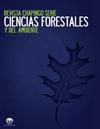Michoacán森林中墨西哥石斛和frontalis齐默尔曼树皮甲虫侵扰的风险
IF 0.6
4区 农林科学
Q3 Agricultural and Biological Sciences
Revista Chapingo Serie Ciencias Forestales Y Del Ambiente
Pub Date : 2021-12-01
DOI:10.5154/r.rchscfa.2020.11.069
引用次数: 1
摘要
引言:北美和中美洲都有严重的松毛虫感染报告。Hopkins和Zimmermann是公认的森林害虫,在墨西哥米却肯州很常见,将包括层次分析法和模糊隶属函数在内的方法与气候和生物物理变量相结合,获得了当前和未来气候情景下墨西哥D.mexicanus和frontalis的森林侵扰风险图。结果和讨论:气候、火灾、树木密度和地形被确定为影响树皮甲虫爆发的相关标准。在当前和未来情况下,墨西哥D.mexicanus估计的最大风险值分别为0.78和0.83;对于D.frontalis,这些值分别对应于0.84和0.85。就面积而言,墨西哥D.mexicanus感染的高风险从3.9%(当前情景)增加到5.0%(未来情景);额D.frontalis从10.8%下降到9.6%。对于物种和情景,非常高风险的值保持不变(0.35%)。结论:在两种模拟情景中,横贯火山带(米却肯州东北部)的森林发生树皮甲虫侵扰的风险最高。本文章由计算机程序翻译,如有差异,请以英文原文为准。
Risk of infestations by Dendroctonus mexicanus Hopkins and Dendroctonus frontalis Zimmermann bark beetles in forests of Michoacán
Introduction: Severe Dendroctonus spp. infestations are reported in North and Central America. Dendroctonus mexicanus Hopkins and Dendroctonus frontalis Zimmermann are recognized as forest pests and are common in the state of Michoacán, Mexico.Objective: To model current and future (2015-2039) spatial distribution of risk D. mexicanus and D. frontalis infestation in forests of Michoacán, Mexico.Materials and methods: Multicriteria evaluation techniques, including the analytic hierarchy process and fuzzy membership functions, were combined with climate and biophysical variables to obtain forest infestation risk maps for D. mexicanus and D. frontalis under current and future climate scenarios.Results and discussion: Climate, fire, tree density and topography were identified as relevant criteria influencing bark beetle outbreaks. The maximum risk value estimated for D. mexicanus was 0.78 and 0.83 for the current and future scenarios, respectively; for D. frontalis these values correspond to 0.84 and 0.85, respectively. In terms of area, high risk of infestation by D. mexicanus increased from 3.9 % (current scenario) to 5.0 % (future scenario); for D. frontalis it decreased from 10.8 % to 9.6 %. The very high-risk value remained constant (0.35 %) for both species and scenarios.Conclusions: Forests of the Transversal Volcanic Belt (in the northeastern part of Michoacán) have the highest risk of bark beetle infestation in the two modeled scenarios.
求助全文
通过发布文献求助,成功后即可免费获取论文全文。
去求助
来源期刊
CiteScore
1.20
自引率
16.70%
发文量
0
审稿时长
>12 weeks
期刊介绍:
The Revista Chapingo Serie Ciencias Forestales y del Ambiente (RCHSCFA) is a scientific journal that aims to raise awareness of high-quality research products related to forest, arid, temperate and tropical environments in the world. Since its foundation in 1994, the RCHSCFA has served as a space for scientific dissemination and discussion at a national and international level among academics, researchers, undergraduate and graduate students, forest managers and public/private entities that are interested in the forest environment.
All content published in the journal first goes through a strict triple-blind review process and is published in the following formats: Scientific Articles, Review Articles, Methodologies, Technical or Technological Notes.

 求助内容:
求助内容: 应助结果提醒方式:
应助结果提醒方式:


